Home Energy Efficiency Equity Loan pilot: homeowner feedback survey - analysis of responses
Impartial analysis of the independent survey of homeowners who participated in the pilot. The analysis covers the impact that the measures implemented had on wellbeing and energy bills, the carbon reductions achieved and homeowner experience of the Equity Loan process and offer. Read the call for evidence: https://www.gov.scot/publications/equity-loan-scheme-call-evidence/pages/1/
3. Impact of measures installed
Survey participants identified a range of positive impacts from their participation in the Home Energy Efficiency Equity Loan Pilot. Personal impacts included lower heating costs and greater wellbeing. More broadly, participants described improvements to their living environment; including their homes being wind and watertight.
Impact on heating costs
Several loan holders described a reduction in the cost of their heating bills. This was more common among loan holders who had installed low emissions heating solutions. Sixty-one per cent (11) of those who installed heating solutions observed a reduction in their heating bill; the equivalent figure among loan holders who installed energy efficiency measures was 43% (12).
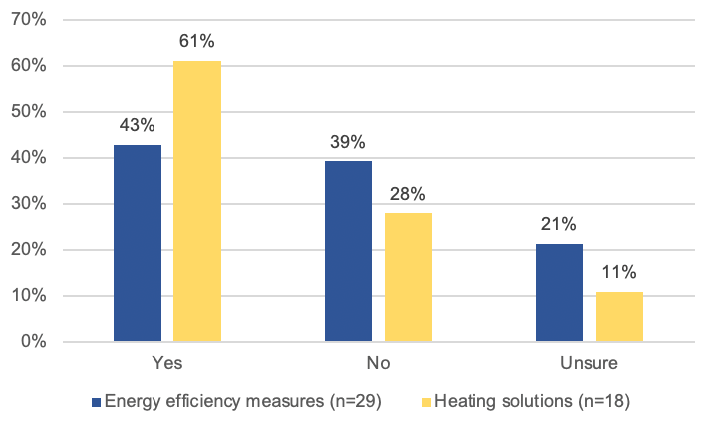
Some loan holders commented on changes in their heating bills after taking part in the scheme, with one saying their bill had reduced by about £20 per month, and another noting they had seen a 25% reduction in their heating costs.One noted an indirect cost saving from having a new boiler; they were no longer paying insurance, as the new boiler that had been installed came with a five-year warranty.
Some loan holders found it difficult to compare their heating costs before and after the measures were installed. They described a lack of certainty because of other contributing factors, such as new energy tariffs, more time spent at home due to COVID-19 and weather conditions, i.e. having been through a particularly cold winter.
A few loan holders, noted that it had been less than a year since the measures were installed so they were unable to compare heating costs with the previous winter.
Impact on awareness of home energy use
The impact of the pilot on loan holders' awareness of energy use is less clear. Figures 3.2 and 3.3 illustrate that the proportion of loan holders who reported 'never' monitoring their home energy use for heat decreased after they took part in the scheme, and there was an increase in the proportion that 'sometimes' monitored their energy use. However, the proportion of loan holders who said they 'always' monitor their home energy use decreased among loan holders who installed energy efficiency measures and stayed the same among those who acquired heating solutions.
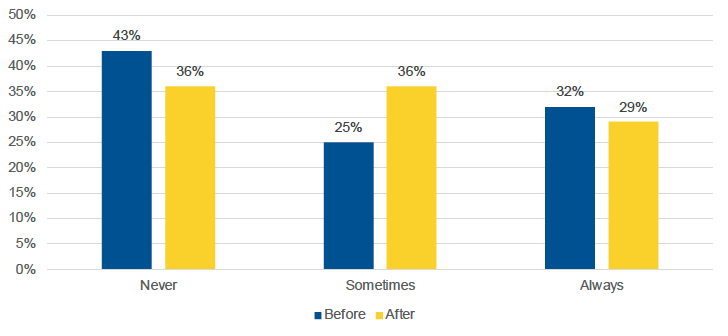
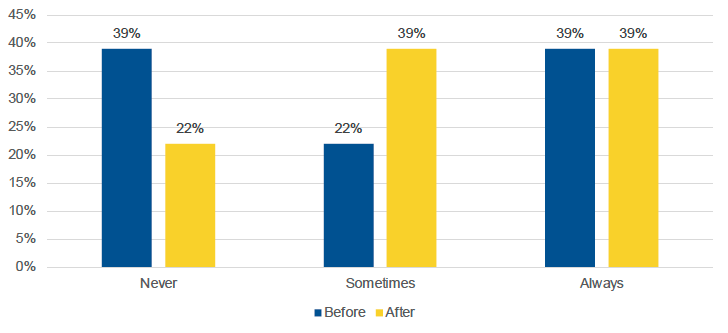
Loan holders who were monitoring their home energy use for heat did so through:
- Keeping track of heating costs
- Electricity and gas meter readings
- Smart meters (one smart meter connected to an app in the loan holders' phone)
- Written statements from their energy provider
Impact on wellbeing
The majority of loan holders confirmed that installing new energy efficiency measures or heating solutions into their property had a positive impact on their wellbeing. Loan holders provided a variety of reasons behind this change, including having a more comfortable living environment and being less stressed about the condition of their property.
More comfortable home environment
A common theme in discussions about improved wellbeing was that loan holders were experiencing more comfortable day-to-day living conditions. Many described having warmer homes as a result of new insulation, more efficient heating systems and double-glazed windows. Twenty-six respondents who installed energy efficiency measures gave quantitative information about their feelings of warmth before and after installing the measures. Nineteen per cent (5) reported they 'always' felt warm in winter before the installation, but this increased to 81% (21) after. Meanwhile, the proportion who indicated they 'never' felt warm in winter decreased from 31% (8) to 4% (1) (Figure 3.4).
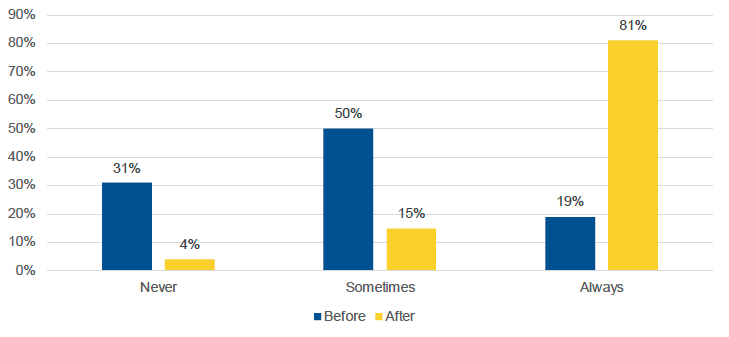
Among those who installed heating solutions, 22% (4) reported 'always' feeling warm in winter before the solutions were installed, but this increased to 83% (15) after. Similarly, the proportion who confirmed that they 'never' felt warm in winter after the measures were installed was only 6% (1) compared with 33% (6) before (Figure 3.5).
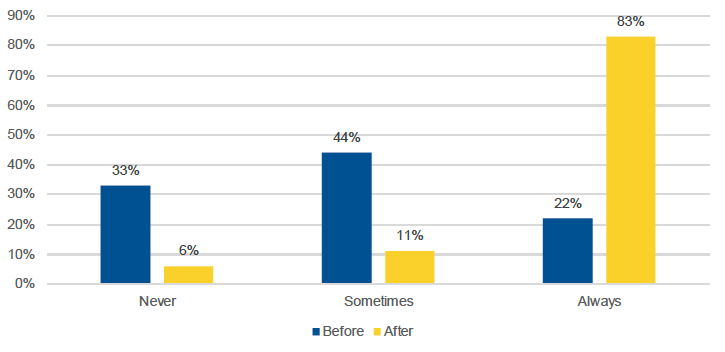
Other benefits which contributed to a more comfortable living environment included having a more reliable hot water source, having a more soundproof home and having damp, dry rot and draughts in their property addressed.
"I'm far happier…I can see the difference because everything is warmer and it's just a far better [heating] system than what I had for years."
"It's lovely and warm and there's no draught. And there is less noise – we're quite near a main road so it's reduced the noise."
"The house is much less damp now. I mean, before I had things going mouldy in the bedroom...but we haven't had that. It's made a vast difference. It's a much, much more comfortable environment."
Less stress and anxiety about their property
Some loan holders described being less stressed about the condition of their homes since taking part in the scheme, using phrases such as 'a great sense of relief' and 'a weight off my mind' and 'stress free'. They felt they were now less likely to experience leaks, boiler breakdowns and damage to their housing fabric in the future, which contributed to their sense of wellbeing.
A few mentioned they were no longer stressed about the financial pressures of heating their homes due to a significant reduction in their energy costs.
Other improvements to wellbeing
A small number were pleased with enhancements to the external appearance of their home, noting that new windows and doors made their property look nicer, which made them feel better as a result. Two noted that the idea of doing something positive for the environment had an impact on their wellbeing.
Impact on energy efficiency and carbon emission ratings
Most loan holders were not aware of any change in their property's energy efficiency and carbon emission ratings after the works were completed. Some simply did not have any awareness or understanding of these ratings, while others had not had their property inspected or evaluated since taking part in the scheme. Those who were aware largely indicated positive changes.
While many loan holders were not able to provide official ratings, some were confident that their property is now more energy efficient after taking part in the pilot.
Impact of repairs
Roughly half of loan holders confirmed they used the Equity Loan to pay for repairs to their property. Loan holders noted that repairs had led to improvements in the condition of their home, making it more wind and watertight.
Those who had repairs to their roof commented on the longevity of such works, and how this brought them peace of mind for the future.
"We're reassured that it's done and it's a long, long time before it needs done again. Roofs are not something that you need to repair that often. That's all been replaced and repaired, it's quite reassuring that it's all done."
"Obviously, because the house has been brought up to a better standard, it takes a lot of pressure off me as I get older. The roof will last another 30 years, and by that time I'll be 97 so I'll not be worried about putting a new roof on!"
Contact
There is a problem
Thanks for your feedback